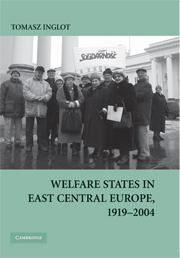Book contents
- Frontmatter
- Contents
- Figures and Tables
- Acknowledgments
- Welfare States in East Central Europe, 1919–2004
- Introduction: Understanding Past and Present Social Policy Development in East Central Europe
- 1 The Welfare State in East Central Europe: A Conceptual and Theoretical Reconsideration
- 2 Institutional Legacies: State Building, Regime Change, and the Development of National Welfare States in Czechoslovakia, Poland, and Hungary, 1919–1989
- 3 Policy Legacies and Welfare States under Communism: Cycles of Social Policy Expansion and Retrenchment in Czechoslovakia, Poland, and Hungary, 1945–1989
- 4 Historical Legacies, Welfare State Institutions, and the Politics of Social Policy Reforms in Postcommunist East Central Europe, 1989–2004
- Conclusion: Postcommunist “Emergency” Welfare States and Theoretical Exploration of Institutional Change and Social Policy Development
- Bibliography
- Index
2 - Institutional Legacies: State Building, Regime Change, and the Development of National Welfare States in Czechoslovakia, Poland, and Hungary, 1919–1989
Published online by Cambridge University Press: 25 July 2009
- Frontmatter
- Contents
- Figures and Tables
- Acknowledgments
- Welfare States in East Central Europe, 1919–2004
- Introduction: Understanding Past and Present Social Policy Development in East Central Europe
- 1 The Welfare State in East Central Europe: A Conceptual and Theoretical Reconsideration
- 2 Institutional Legacies: State Building, Regime Change, and the Development of National Welfare States in Czechoslovakia, Poland, and Hungary, 1919–1989
- 3 Policy Legacies and Welfare States under Communism: Cycles of Social Policy Expansion and Retrenchment in Czechoslovakia, Poland, and Hungary, 1945–1989
- 4 Historical Legacies, Welfare State Institutions, and the Politics of Social Policy Reforms in Postcommunist East Central Europe, 1989–2004
- Conclusion: Postcommunist “Emergency” Welfare States and Theoretical Exploration of Institutional Change and Social Policy Development
- Bibliography
- Index
Summary
The major aim of this chapter is to explain how in all three countries the original “core” of the welfare state evolved under different political and economic systems, gradually adding layers of new and supplementary benefits and allowing only partial restructuring, adjustment, or conversion of the original social insurance institutions established in the interwar period. I argue that institutional legacies of the welfare state not only reinforce path dependence on their own but do so in conjunction with the legacies of the political regime and with regime change, exemplified by the crucial periods of state building and rebuilding in each country since 1919. In keeping with our analogy of an East Central European welfare state as a permanent “construction site,” we should not expect Czechoslovakia, Poland, and Hungary to settle into a fixed type of a social policy regime under any particular political system, but instead during the period examined in this study we would witness the continuing evolution of “emergency” welfare states, from their Bismarckian origins to the contemporary postcommunist stage. As we see below, however, regardless of this inherent pattern of instability, at different historical moments each country created a main “edifice” or “blueprint” of national social policy that subsequently would serve as a guide in the process of institutional growth and adaptation. The type of these blueprints, their timing, and their placement in a particular developmental path of a welfare state would play a vital role in the process of “institutional layering,” a mechanism that produced considerable cross-national variation in pensions, sickness benefits, family allowances, and also other major policy areas.
- Type
- Chapter
- Information
- Welfare States in East Central Europe, 1919–2004 , pp. 54 - 118Publisher: Cambridge University PressPrint publication year: 2008



